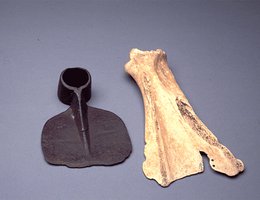

The archaeological record in western and central Nebraska suggests that Native American people migrated to the region somewhere around 1675 CE. We think they came from further west and north. Archaeologists have found evidence of these people and named the culture after where the sites were discovered in the 1930s — along the Dismal River in the Nebraska sand hills. Dismal River Cultural sites also have been excavated in the Republican River basin. So, the Dismal River cultural complex occupied much of the western part of Nebraska. They were thought to speak an Athabascan language now spoken by the Apache and Navajo of the Southwest and southern Plains areas.
These people were nomads who walked on their hunts — at least until horses came into Native American cultures. They lived principally off the bison. They did, however, erect villages with fairly large, circular dwellings whose post outlines resemble circular hogans of the Navajo. Their dwellings were apparently covered by skins or other light coverings, rather than the earth-covered lodges of the Lower Loup people.
Iron hoes were more efficient than bison shoulder blade hoes and were popular trade items among village tribes during the historic period.
Dismal River people had a subsistence economy based primarily on hunting and secondarily on farming. In other words, they lived on the meat and other products they got from killing bison as well as the crops they grew near their villages. While bison were the chief animal hunted, deer, beaver, birds, turtles, and freshwater mussels were also eaten. Evidence for farming is present, but limited. Digging tools made from bison shoulder blade bones have been recovered from several sites. Charred remains of corn, squash and gourds provide direct evidence of domesticated plant use. Remains of plums, chokecherries, hackberries, and black walnuts have also been recovered. Chipped stone and bone tools have been found including projectile points, scrapers, knives and drills, bison scapula hoes, fleshers, and bone awls. Ceramic vessels have also been recovered. Dismal River pottery is characteristically gray-black in color with a smooth or simple stamped surface.
In later historic documents, these people were called Padoucas. They left Nebraska and migrated south by 1725, replaced by Numic-speaking Comanches, who also became known as the Podouca.